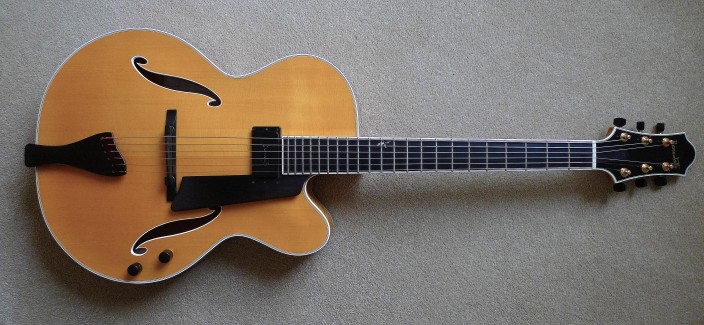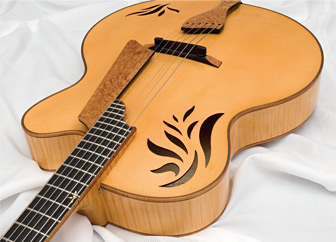Archtop Guitars
Perhaps the highest form of guitar building is the construction of archtop guitars. These instruments are more closely related to the violin / cello family than the guitar family – the way the strings’ energy is transferred into driving the soundboard is rather different – an archtop instrument is driven by a bridge that presses down on the soundboard (the ‘arching’ of the top designed to resist the tendency for the soundboard to collapse inwards) as opposed to a ‘flat topped’ acoustic guitar where the bridge exerts an upward pull on the soundboard.
Archtops are traditionally thought of a jazz guitars – the original design pioneered by Lloyd Loar – predated amplification, and the idea was to provide guitarists with an instrument with enough volume and the right kind of percussive attack to allow them to be heard above the large swing bands of the time.
In its purest form the archtop guitar is just like a cello or violin – with solid, carved, front and back plates made from spruce and maple. The high art of archtop building lies in the carving of these two plates; hand carved into complex curves and re-curves, and with constantly varying thickness these plates are ‘tap tuned’ by the maker so they ring with a pure fundamental note. They need to be thin enough to move freely and pump the air inside the guitar body, but not too thin that the guitar collapses inwards – the finest guitars are those on the point of imploding due to string tension.
When amplification arrived, the archtop remained as a ‘jazz’ instrument, the tight centred tone, and ability to keep notes within complex chord voicings clearly separated, suited the genre. But the solid topped archtop proved highly susceptible to feedback so various manufacturers started to produce archtops with laminated wood soundboards which kept most of the desirable tone but with less of the tendency to feedback.
I’ve owned several archtops over the years – they are such beautiful instruments and I’m really interested in their construction but I am by no means anything other than a very amateur jazz player. Now I have a Bendetto Bravo Deluxe, an instrument so far beyond my playing abilities that it is almost criminal, but it is much loved, and, if nothing else, deeply inspirational.
Bob Benedetto is thought of a modern Stradivarius, the design aesthetic and construction of his guitars are incredible. The Bravo is one of his more basic ‘professional’ models, with a laminate, rather than a solid carved, top. The solid top instruments he makes are among the most sought after, beautiful and musical instruments ever made.


